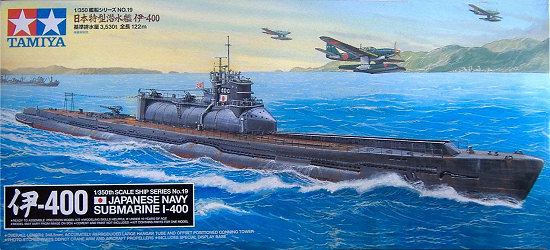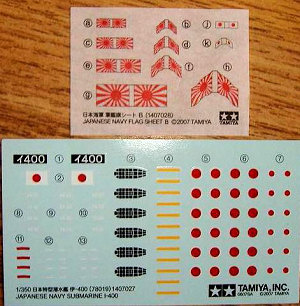
Tamiya 1/350 I-400 Submarine
| KIT: | Tamiya 1/350 I-400 Submarine |
| KIT #: | 78019 |
| PRICE: | $69.00 MSRP |
| DECALS: | One option: sub and six aircraft |
| REVIEWER: | Bruno Schielzeth |
| NOTES: | Some possible paint/profile errors |

| HISTORY |
The Japanese interest in submarines dates back to at least 1904 when they purchased 5 Holland class submarines from the United States. They also purchased submarines from England and France and they license-built units of Italian design.1
After WWI Japan received seven German submarines as reparation. Japan’s involvement in submarine development blossomed with the possession of the then state-of-the-art German vessels.
Japan was also interested in submarine carried aircraft from at least 1921 when they purchased a Kaspar U-1 biplane from Germany to use as a pattern aircraft. In 1927 the first Japanese design, the Yokosho I-GO, flew for the first time.2 The stage was set for the I-400.
Japan envisioned the next war being fought with fleets of various classes of submarines used for coastal protection, long-range reconnaissance, including several that carried disassembled planes in a waterproof hanger, attack, and command vessels.3 Following those precepts they designed and built a variety of submarines capable of only certain tasks.
In WWII that strategy, among others, would prove to be their undoing as the Japanese submarine force proved to be almost entirely ineffective in WWII. When the war started Japan had more submarines in the Pacific Ocean then all the Allied submarines combined! It made very little difference to their war effort.
The Allied submarines went on independent ‘hunter-killer’ missions for capital ships and anything else afloat. Japanese submarines continued to try to co-ordinate a mass execution of Allied ships that never quite came together. The failure of the Japanese reconnaissance submarines at Midway was but one example.
Except for the sinking of the USS Indianapolis and the sinking of the already badly damaged USS Yorktown, the Japanese submarines of WWII contributed little to the war effort. The strategy of a ‘single, massive knock out punch’ by a large group of submarines on an American fleet of capital ships could never be implemented, in part because we had broken their secret codes and in part because we never planned to enter into a ‘slug fest’ with the Japanese navy. In effect the Japanese submarines milled aimlessly around the Pacific Ocean looking for the ‘big battle’ and were picked off one by one by US forces. Most of them had never even fired a shot!
In early 1942, flush with the successful attack on Pearl Harbor, Adm. Isoroku Yamamoto ordered the development of a special submarine class. The I-400 class of submarines was to be able to carry two or more attack aircraft capable of carrying a single torpedo or an 800-kilogram bomb. A range of 40,000 nautical miles without refueling or resupply to reach the East Coast of America was requested.1 Such a submarine had never existed and, as far as the world would know until late 1945, it never did exist.
The first of three I-400 class submarines was begun in Kure Dock Yards in early 1943 and was launched in late 1944; an astonishing feat considering the lack of steel and raw materials available to Japan at that time in the war. The I-400 displaced 3,530 tons surfaced, 5,223 tons submerged. It was 400.3 feet long, 39.3 feet in beam, and a draft of 22.9 feet. Its range was an astounding 37,500 nautical miles, one and a half times around the world! Submerged speed was 6.5 knots with 18.7 knots on the surface. 3 It carried three Seiran attack aircraft developed just for this class. It also had 8 forward torpedo tubes that launched the formidable Type 95 Long Lance, perhaps the best torpedo carried by any submarine in the world at the time. The topside armament included a 5.5-inch deck gun, and one single and three triple 25mm antiaircraft guns.
The I-400 class was, without a doubt, the longest ranged and largest submarine in the world until the United States launched the USS Benjamin Franklin (SSBN-640) in 1965!1 Tamiya’s instructions say the USS Triton (SSN-586), launched in 1959, was the first submarine as large or larger than the I-400 class, and I believe they called it correctly.
Tamiya released a 1/350th scale model of I-400 class this summer and it’s a real winner!
| THE KIT |
 Opening the sturdy compartmented box reveals a neatly packaged model. The most
obvious parts are the delicately detailed 13.75-inch long upper and lower hull
and the shiny sheet of etched metal details. The lower hull is molded in red
plastic and except for two tiny sprue points on the keel, is ready to use. The
beautifully detailed upper hull only needs to have two runners removed before
use. Neither part shows any molding defects, sink marks, or any visible ejector
towers.
Opening the sturdy compartmented box reveals a neatly packaged model. The most
obvious parts are the delicately detailed 13.75-inch long upper and lower hull
and the shiny sheet of etched metal details. The lower hull is molded in red
plastic and except for two tiny sprue points on the keel, is ready to use. The
beautifully detailed upper hull only needs to have two runners removed before
use. Neither part shows any molding defects, sink marks, or any visible ejector
towers.
The etched detail parts include the launch catapult, three aircraft dollies, five aircraft propellers, the upper portion of the aircraft crane, and various other small bits like antenna mounts.
 There are two sprues of
gray plastic for the decks, guns, sail and hanger deck, and various other small
parts. There are two identical sprues for the six Seiran planes. Four of the
planes are assembled with their wings, tails, and rudders in the folded position
and the other two are displayed fully erected. One set of floats and one 800 kg
bomb are also included on each sprue.
There are two sprues of
gray plastic for the decks, guns, sail and hanger deck, and various other small
parts. There are two identical sprues for the six Seiran planes. Four of the
planes are assembled with their wings, tails, and rudders in the folded position
and the other two are displayed fully erected. One set of floats and one 800 kg
bomb are also included on each sprue.
 Examination of the sprues showed
no molding defects, sink marks, or ejector towers on any visible surface.
Amazingly they showed almost no mold parting lines either. Cleaning up the parts
before assembly will be very quick! The detail on the parts is truly delightful!
All flooding and drainage holes are deeply molded and should look realistic with
a dark wash. The delicate but crisp detail is almost unbelievable! Even a fairly
heavy coat of paint won’t hide it.
Examination of the sprues showed
no molding defects, sink marks, or ejector towers on any visible surface.
Amazingly they showed almost no mold parting lines either. Cleaning up the parts
before assembly will be very quick! The detail on the parts is truly delightful!
All flooding and drainage holes are deeply molded and should look realistic with
a dark wash. The delicate but crisp detail is almost unbelievable! Even a fairly
heavy coat of paint won’t hide it.
The decal sheet contains decals for the I-400 only, but includes full decals for the Seiran aircraft including decals for the cockpit glass and yellow wing ID stripes. See my painting notes below about the Seiran aircraft. There is a small paper sheet of Japanese flags in various sizes, a metalized sheet for the display stand with both Japanese and English plaques, and a package of steel weights for the lower hull.
Also in the box is a package of mounting hardware and metal propeller shafts, and a display stand for both the submarine and one Seiran.
The 17 page instruction manual includes Tamiya’s standard clear assembly steps and color profiles of the I-400 and the Seiran aircraft.
Sadly the clear hanger deck mentioned before the model’s release is a no-show. It would have added a very unique touch to the model.
| CONCLUSIONS |
The profile and painting guide in the instructions show a red oxide lower hull. This is incorrect according to pictures of the captured I-400 and I-4011. Both submarines carried an unusual anti-acoustic covering of grayish tar/asbestos and fiber designed to make them less visible to sonar. It is probable that I-402 never had the coating applied, as it was never completed before the end of the war. It’s a minor point, but one worth considering before you paint the hull. The profiles also show the sub with wooden decks. All the decking was painted with black anti-slip coating. These points are made in the instructions, but they are easily missed.
The Seirans were also probably still painted in silver lacquer and had US markings applied for their attack on the Panama Canal while the profile shows them in their normal Japanese colors and markings. There is some ‘wiggle room’ here, but it is unlikely the planes were repainted before they were ditched in the ocean, at least in my opinion. Reports from the captured pilots stated that the planes were ditched while still in American markings.1 1/350th scale US insignias will have to be found elsewhere as none are supplied in the kit’s decals. Also of note was the fact that the Seirans did not have the floats mounted to them before launch, as the mission was a one-way flight.
| REFERENCES |
1 Osprey Publishing. Imperial Japanese Navy Submarines 1941-45.
2 Mushroom Model Magazine Special. Japanese Submarine Aircraft
3 Hikoki Publications. I-400. Japan’s Secret Aircraft-Carrying Strike Submarine.
Review kit courtesy HobbyLink Japan, get yours at Japanese prices at www.hlj.com
Oct 2007
If you would like your product reviewed fairly and quickly, please contact me or see other details in the Note to Contributors.